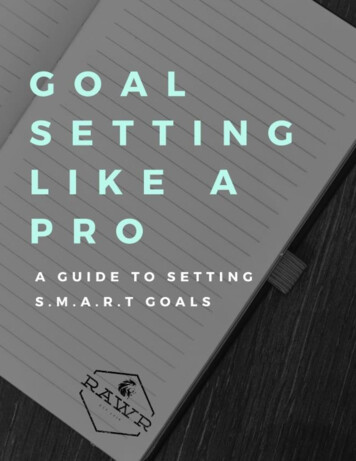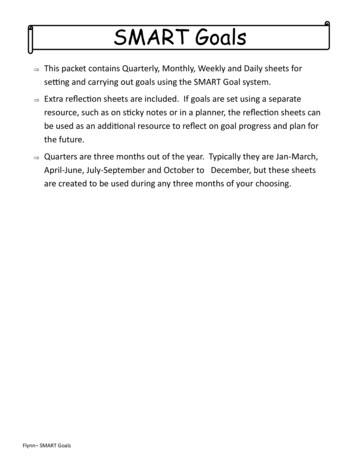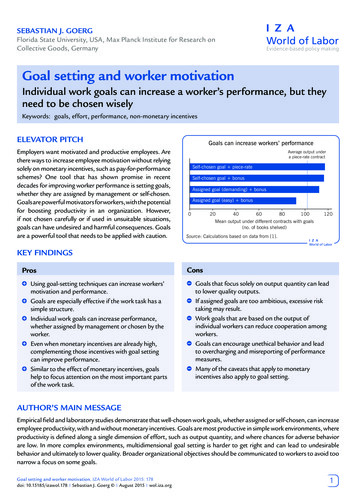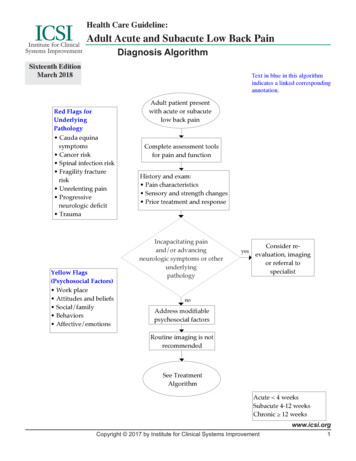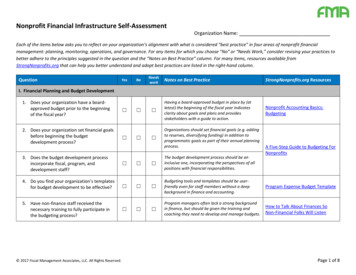
Transcription
ThePowerofGoalsRobert M. Sheehan, Jr., PhD
You are probably well experienced at goal setting.And, yet, in this brief article I’ll share some uniqueinsights that can help you take the power ofgoal setting to an entirely new level. Applyingthese insights will give your goal setting processexceptional – even transformational – powerthat can lead to a more fulfilling life and a higherperforming organization.Yet, when given the freedom to choose, mostpeople do not set goals or they do not set themeffectively.They choose to “go with the flow.”The truth is that every now and then, going withthe flow is not a bad thing. But just rememberthat every time we do that, we let the “flow” takeus where it wants, versus where we would haveBecause of its power, goal setting is one of theintentionally chosen to go. And sometimes wemost researched aspects of organizational life.can drift far away from where we would haveThere are dozens of good books you could read,intentionally chosen to be.but I will summarize the research and add what I’velearned during my 30-plus years ofconsulting, academic research, anddirect hands-on work experiences.These ideas are the essence ofwhat I believe people need to knowif they want to harness the power ofThis leads us to the first importantfinding from the research on goalsetting:1Goals direct attention andaction toward relevantactivities and away fromnon-relevant activities.goal setting for success.Think about that.Goals Versus “Go withthe Flow”For your day-to-day actions tobe relevant – to address someMost of us want to use our timein ways that are more relevant –aspect of your personal or worklife that you really care about – it’simportant to set effective goals.relevant to what we care aboutHow? Read on.most in life.“2Goals direct attentionand action towardrelevant activitiesand away from nonrelevant activities.”
Set Goals as Outcomes,Not Activitiesindividual or team to work on rather thanYou will increase your personal andproduce. One reason why is that languagethe outcomes the activities are intended toorganizational effectiveness by setting youraround performance often lacks rigor.goals as “outcomes” instead of “activities.”A typical question asked of direct reportsSetting goals as outcomes makes youby supervisors is “What are you working onfocus on what you really want.during the upcoming quarter?” instead ofHere’s a simple example:“What outcomes will you produce during theRaise 500,000 in cash gifts by Nov. 1Notice the goal is not to mail 100,000 fundraising letters or make 10,000 phonathonupcoming quarter?”This lack of rigor, or definition ofexpectation, makes it more difficult forcalls. The goal is to raise 500,000. Howthat is accomplished is through activities.When you are considering goals – whetherpersonal or organizational – always definethe result, the outcome, really desired.Once you set an outcome-based goal thenit is totally fine to connect activity-basedgoals to it. Realize though, that just becausean activity is completed does not mean thatthe desired results are produced.Unfortunately, outcome-based goals are alltoo rare in organizations.“It is easier to listthe activities for anindividual or teamto work on ratherthan the outcomesthe activitiesare intended toproduce.”It is easier to list the activities for an3
people to be held accountable. Completingan activity is easier than producing anagreed upon outcome.I’ve seen this problem at individual, team,and organizational levels. When we holdaccountable others or ourselves for anUse the SMRT Goal FormulaNo, it’s not a typo. We’ll get to the “A” inSMART goals next. For now, focus on theSMRT part.To be more effective, goals should be:outcome, failure is a possibility as are1. Specific & Measurableconsequences. People naturally wantVague goals do not provide focus -- and areto avoid failure and activity-based goalsalmost impossible to measure.don’t engender much accountability.When we set personal goals, we needto overcome this. And as supervisors,we need to work with others to designoutcome-based goals.Setting outcomes can bechallenging for some types of work,but it can be done. Two excellentresources that can help you inestablishing goals as outcomes areMake Success Measurable (1999)by Doug Smith, and First Break Allthe Rules (Buckingham & Coffman, 1999)You know that a goal is fully specific andmeasurable when there can be no objectiveargument over whether it has been achieved.Relying on opinions of various people aboutwhether or not the goal has been met doesnot move organizations (or people) forward.Vague goals, like “Do your best,” allow peopleto interpret effort in a variety of ways.When you set specific goals, like “Raise 20,000 from phonathons by Friday,”then people will expend more intense andpersistent effort to meet the goal.It is simple common sense, backed up byresearch:2The more specific the goal, the moreexplicitly performance is regulated.2. RelevantDon’t waste time on trivial goals. Think aboutthe goals relevant to your organizational orpersonal mission that will catapult you towardthe future you want to create.Make setting the most relevant goals a priority4
3. Time-BoundExcept for one thing. Goal researchEvery goal should have a date attached to it.does not support this. Instead, researchSimply make sure that you add the phrase “bydemonstrates:Month, Date, Year” to every goal you set.Ok. Here comes the “A” part.The more difficult the goal, thehigher the level of performance.3So, set a relatively easy “Attainable” goalAnd there is more to consider than youand chances of succeeding are higher –may expect.but the overall level of performance mayThere are more than one hundred differentbe lower.versions of the popular SMART Goal formula.Hmmmm.Three versions all have the same words forSome advocate setting relatively low goalsSMRT as explained above. The difference inwhen the consequences of failing are toothe three versions is the “A” word. Your choicerisky. So, just convince your boss thatof the “A” you pick should be based on whatyour easy goals are really hard so you canyou want the goal to do for you.succeed and look good. (This goes on everySMART v. 1.0– Attainable GoalsOne popular SMART version emphasizes thatgoals should be Attainable.year in organizations around the globe!)Okay – that’s a little cynical. But the desireto avoid punishment for failing at a goal isunderstandable.There are many good reasons forMany people who teach this version coachsetting goals that are relatively easy toothers not to set a goal unless it is believed toaccomplish. One is to build momentumbe at least 80% Attainable.with “quick wins” on a new project (low-The reasoning is simple: you don’t want to sethanging fruit is the easiest to pick, right?).a goal and then fail at it.Another could be setting Learning Goals inThat seems reasonable enough sincesituations when it is difficult to judge whatwe can all think of times when we – oris easy and what is hard.others – experienced significant negativeAnd finally let’s face it; some people deal withconsequences from failing to achieve a goal.setbacks better than others. Setting easierTherefore, setting goals that are easilyAttainable seems to be a SMART thing to do.5
goals for a team you think lacks confidenceWell, yes. Setting Aggressive goals willmay be the way to go for a while.improve your personal performance or that ofBut don’t forget the research – more difficultyour organization.goals result in higher levels of performance.But, setting Aggressive goals for a teamAnd despite the pushback you might get,needs to be done carefully.most people like to be challenged.First, examine your reward system. ExpectSMART v. 2.0– Aggressive Goalslots of push back on Aggressive goals ifSome SMART Goal advocates use the wordavoid punishment.“Aggressive.”A great way to apply Aggressive goals is toUsing “Aggressive” as the A in SMART helpsreward for performance.to leverage the research:Here’s a quick example:you punish failure for not meeting goals. It’shuman nature: people will set easy goals to4The more difficult the goal, the higherthe level of performance.Aggressive goals are often defined as thosethat have about a 35% chance of beingaccomplished versus the 80% chance withAttainable goals.Hold on now. It’s good to set goals with atwo-thirds chance of failure?In the nonprofit world, many organizationsuse a reward system for fundraising basedsimply on meeting goals. That motivatespeople to set an Attainable goal so they willbe rewarded.Changing your focus to reward outcomes– dollars raised, in this case – then actualperformance is rewarded. This gives peopleWhich is better: An Attainable goal of a fivepercent increase for a 100,000annual fund which produces 105,000?6Or An Aggressive goal of a 15%increase that produces 112,000but does not meet the goal?
freedom to set Aggressive goals. In fact, ifFor innovation and breakthroughthey understand that Aggressive goals willperformance, set Almost Impossibleimprove their performance, then they will beStretch Goals.motivated to set them.SMART v. 3.0 – AlmostImpossible Stretch GoalsUsing Almost Impossible as the “A” inBy definition, an Almost Impossible StretchGoal is one that you think has only a 1%chance of being accomplished and – youdon’t know how to do it.SMART is required if you want innovationWhy do I recommend Almost Impossibleand breakthrough performance.Stretch Goals? Because one of myThere are times, many times, that setting anAlmost Impossible Stretch Goal – a goal thatyou think only has a 1% chance of beingaccomplished – is the SMART thing to do.Attainable goals help focus effort.favorite sayings is “Great Leaders Havea Healthy Disregard for the Impossible.”5Think about that.What things have we all been told wereimpossible, and yet they were achieved?Aggressive goals produce improvedperformance. But in today’s world,improved performance is often not enough.Many nonprofits want and need to makehuge improvements in the quality of lifefor those they serve. Whether it is closingthe huge gaps in hunger, high schoolgraduation rates, homelessness, literacy,and countless other issues – incrementalprogress is not good enough.“What are yourdreams? Whatinspires you?What goals, if youachieved them,would make abreakthroughdifference?”7
People told Roger Bannister that it wasThis is the concept of “creative tension” asimpossible to run a mile faster than in fourdescribed by Peter Senge in his book, Theminutes. But he set the goal. And was theFifth Discipline (1990). And it’s a concept thatfirst to do it.works.In 1961 John F. Kennedy set the goal for theIn 1994, when Jack Welch was CEO ofUSA to land a man on the moon and safelyGeneral Electric, he commented on GE’s usereturn him by the end of that decade. Manyof the Almost Impossible Stretch:experts gave lots of scientific reasons forwhy it was impossible. But he set the goalanyway. And it happened in July 1969.produced smirks, if not laughter, in the GE ofthree or four years ago, because it essentiallyIf, 25 years ago, you predicted that most ofmeans using dreams to set business targetsus would carry a small device that we could-- with no real idea of how to get there . . . ifuse to make phone calls, listen to more thanyou do know how to get there then it is not10,000 songs we had recorded on it, anda stretch target . . . In a company that nowaccess endless information from computersrewards progress toward stretch goals, ratheraround the world, you would have been told itthan punishing shortfalls, the setting of theseis impossible. But people set such goals. Andgoals, and quantum leaps toward them, areour lives have changed forever.daily events. {And these targets} are makingGeorge Bernard Shaw once said “Some mensee things as they are and say ‘why,’ I dreamof things that never were and say ‘why not.’”What are your dreams? What inspires you?seemingly impossible goals exciting, bringingout the best from our teams.”6So how does this Almost Impossible StretchGoal setting work?What goals, if you achieved them, wouldOnly set Almost Impossible Stretch Goalsmake a breakthrough difference for you or forthat really inspire you. You won’t put in thethose your organization serves?required effort if you are not truly inspired.Almost Impossible Stretch Goals ignite ourcreativity. Since, by definition, we set thegoal so big that our current methods ofgoing about them will not work, our creativity8“Stretch is a concept that would haveWith an Almost Impossible Stretch Goal inhand, you automatically think of new ways tomake it happen – and you can get others tohelp you out.automatically kicks in to start thinking of newThe next time you and your team gather to setways of achieving the goal.annual goals, do it the way you always have.
Then take another thirty minutes toFor the next year, I set a goal of raisingbrainstorm. Pose this scenario: 150,000 – and I told no one.“Let’s imagine we get into a time machineI thought about how we could raise moneyand travel ahead one year from now and findcompletely differently than we had been.that, somehow, we produced FIVE TIMESAnd I met with people I worked with andbetter results than the goals we just set. Soasked, “Wouldn’t it be cool if we did WAYhere’s my question: What new, different, andbetter than last year? What would weamazing things must we have done duringhave to do differently to produce a realthe past year that allowed us to producebreakthrough in our results?”those results?”Then let the brainstorming commence.If you come up with some new ideas thathave promise, then try them out and see ifthey help you produce some breakthroughs.I never told anyone my actual goal. But,they did come up with new ideas. After afew weeks I had a totally new design for theproject – a new methodology about how toraise the money.This is a way to softly introduce the idea ofMy boss approved the new plan, which sheAlmost Impossible Stretch Goal setting, andthought should have a goal of 75,000. But Iyou can build on the approach from there.kept private my goal of 150,000.When I was a doctoral student at Ohio StateWe raised 143,000 that year – short of myI had an assistantship in the campus fund-goal, but more than double the previous year.raising office and was put in charge of aproject with a poor fundraising record. Myboss set an aggressive goal of 50,000 andwe beat it by raising 62,000.Then I started learning about AlmostImpossible Stretch Goals.And how did I feel about “failing” at my 150,000 goal? I thought it was a “noblefailure” and I was delighted with the results,as were my bosses.That’s an example of the power of AlmostImpossible Stretch Goals.9
“There’s no substitute for getting smarter faster.And the way you get smarter is to screw aroundvigorously. Try stuff. See what works. See whatfails miserably. Learn. Rinse. Repeat.”Tom PetersManagement ConsultantCelebrate Noble FailureTo successfully implement Almost ImpossibleStretch Goals is to allow yourself and othersto play with new ideas and be creative. Tohave that freedom, you can’t be worriedabout failure.In fact, if you cannot live with the worstprobable outcome from the failure of anAlmost Impossible Stretch Goal, then youshould set the goal lower.performance. But when focus is on thedelight of increased performance and noton the distaste of failure, the relationshipwith failure is transformed.It’s no surprise that research shows thatorganizations are only effective usingstretch goals if they have a safe-fail workenvironment.8 If you don’t have that kindof environment where you work, then myadvice is to keep setting small AttainableOtherwise, go for it. And accept that notGoals – publicly, with your bosses, etc.every idea ends in success.– and then set Aggressive or AlmostI know a corporate executive who said oneImpossible Stretch Goals that you keep toof her favorite sayings is “We celebrateyourself. You can be publicly successful andnoble failure.”produce higher levels of performance.Going all out – not irresponsibly, butManagement guru Tom Peters said,enthusiastically – and not fully achieving the“There’s no substitute for getting smartergoal is noble failure.faster. And the way you get smarter is toBut most people, and most organizations,screw around vigorously. Try stuff. See whatusually don’t “go for it” because they areworks. See what fails miserably. Learn.afraid to fail.Rinse. Repeat.”Yet, IBM’s Thomas Watson, Sr., once saidI put this philosophy into action when I“The fastest way to succeed is to doubleserved as CEO of LeaderShape, Inc., ayour failure rate.”7nonprofit which provides ethics-basedThe singular fear of failure keepsorganizations from making more of a10difference and people from increasingleadership programs for college studentsall across the country (and today, across
the world). My mandate from the Board offavorite quotes as “Great Leaders Have aTrustees was to grow the attendance at ourHealthy Disregard for the Impossible.” Thissix-day flagship program, The LeaderShapeis the philosophy of innovators.Institute. I taught the Almost ImpossibleStretch Goals approach to our staff andpromised a “safe-fail” environment.Transform your relationship with failure.Learn to celebrate “noble failure” and getsmarter faster.The LeaderShape team was inspired touse the Almost Impossible Stretch Goalsetting approach because we knew what awonderful, positive experience attending TheLeaderShape Institute was for young adults.2500Results of LeaderShape’sStrategic Stretch GoalsFor nine years, we set Almost ImpossibleStretch Goals for the number of participants2000attending The LeaderShape Institute. Andevery year we failed. Did this demoralizethe staff? No. Because we focused on1500actual results, not on the goal, no onewas demoralized. From 1992 to 2001 weincreased the number of annual participants1000in the program from 229 to 2,230.By the way, we also taught AlmostImpossible Stretch Goal setting in the500LeaderShape graduates from the 1990sis Larry Page, who went on to co-foundGoogle. To this day, he recites one of 971998199920002001LeaderShape program. And one of thoseNumber of Participants (1986 – 2001)11
In Summary5. SMART v. 2.0:1. Set GoalsThe mere act of setting even general goalsAggressive Goals, which you have a 35%helps direct attention to relevant activities.chance of accomplishing, will improve yourKeep your life and work more relevant byperformance. Research shows that thesetting goals.more difficult the goal, the higher the levelof performance. If you feel like you have a2. Set Goals as Outcomesgood system and you want to maximizeFocus on what you really want, the results –not the activities.performance of it, then this method will helpyou do it.6. SMART v. 3.0:3. SMRTAlmost Impossible Stretch Goals, whichMake sure that ALL your goals are Specific,you have a 1% chance of accomplishing,Measurable, Relevant, Time-Bound. Thewill require you to design innovative waysmore specific the goals, the more explicitlyof going about accomplishing your goal.performance is regulated.“Working harder” on the same processwon’t do it. You have an opportunity for4. SMART v. 1.0:Breakthrough Performance with AlmostImpossible Stretch Goals.Attainable Goals, which you have an80 % chance of accomplishing, are goodif failing will have many negativeconsequences. Attainable goalsare good to build some momentumwith easy wins, or to learn moreabout new environments, or ifyou are concerned about gettingdiscouraged.12“The fastest way tosucceed is to doubleyour failure rate.”Thomas Watson, Sr.Chairman Emeritus, IBM
7. Celebrate Noble FailureIf you are inspired to pursue a goal and you go for it, but you don’t make it all the way,then appreciate the progress you have made and appreciate that you worked hard atsomething you really cared about. This approach will bring you more long-term successthan letting the fear of failure keep you from doing what truly inspires you.If you use these principles and apply them to your personal and work life then I promiseyou much higher levels of performance, fulfillment, and satisfaction. And that will make asignificant impact on your quality of life and the quality of life of those you serve.Good luck with all of your goals!Locke, E.A. & Latham, G. P. A Theory of Goal Setting & Task Performance. Englewood Cliffs, NJ: Prentice Hall, 1990.Ibid.3Ibid.4Smith, D. Make Success Measurable, New York: John Wiley & Sons, 1999.5Thanks to Gene Hoffman for this gem.6Hyatt, J. GE Chairman’s Annual Letter Notes Strides by ‘Stretch’ of the Imagination,The Wall Street Journal, March 8, 1994, p. 1.7Farson, R. & Keys, R. The Failure Tolerant Leader, Harvard Business Review,August 2002, pp. 64-71.8 Thompson, K., Hochwarter,W. & Mathys, N. 1997. Stretch targets:What makes them effective? Academy of ManagementExecutive, (11)3, pp. 48-60.1213
The author, Dr. Rob Sheehan, is the AcademicDirector of the Executive MBA Program at theRobert H. Smith School of Business at theUniversity of Maryland – College Park, wherehe also serves as a Lecturer for the Facultyof Management & Organization. He has morethan thirty years of executive managementexperience, including serving as CEO of twodifferent national nonprofits. He is authorof Mission Impact: Breakthrough Strategyfor Nonprofits, a book which provides aprocess for driving innovation throughout anonprofit organization. He can be contacted kedInCopyright 2012 Robert M. Sheehan, Jr., PhD
Set Goals as Outcomes, Not Activities You will increase your personal and organizational effectiveness by setting your goals as “outcomes” instead of “activities.” Setting goals as outcomes makes you focus on what you really want. Here’s a simple example: Raise 500,000 in cash gif
